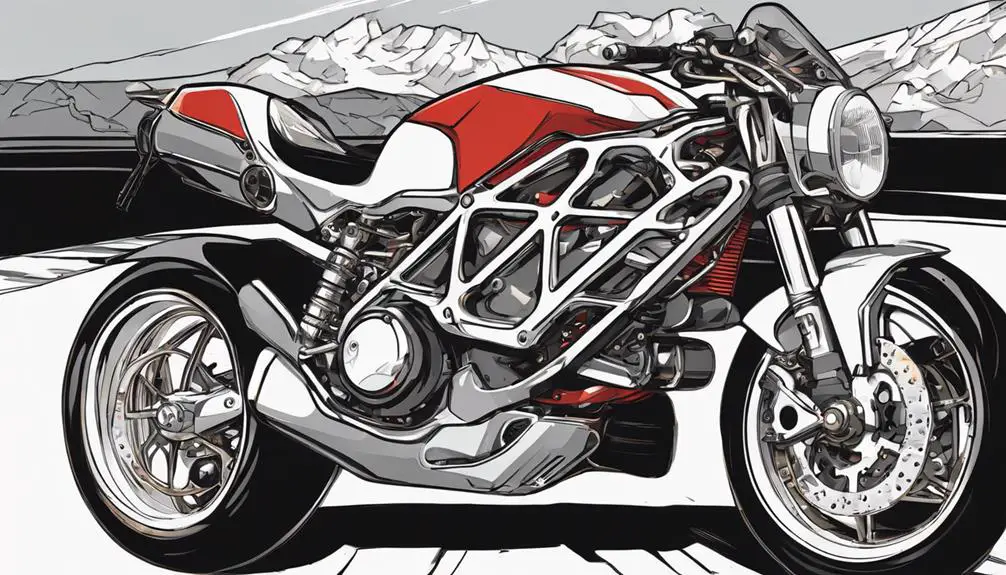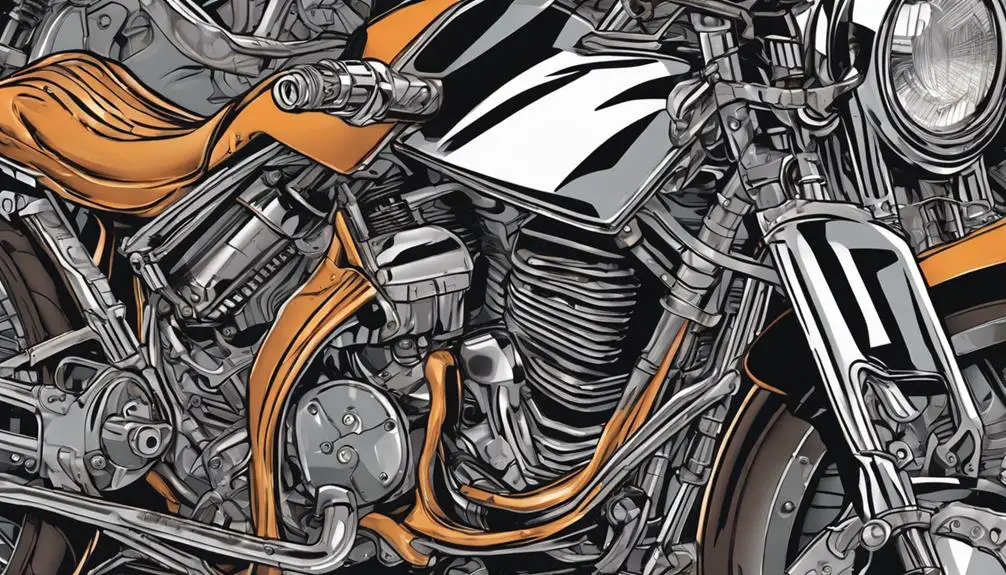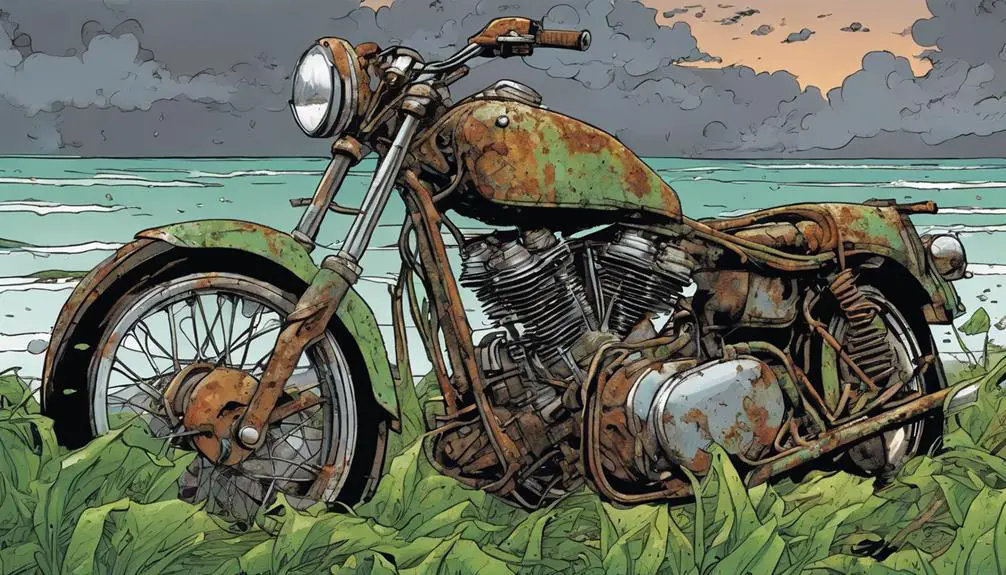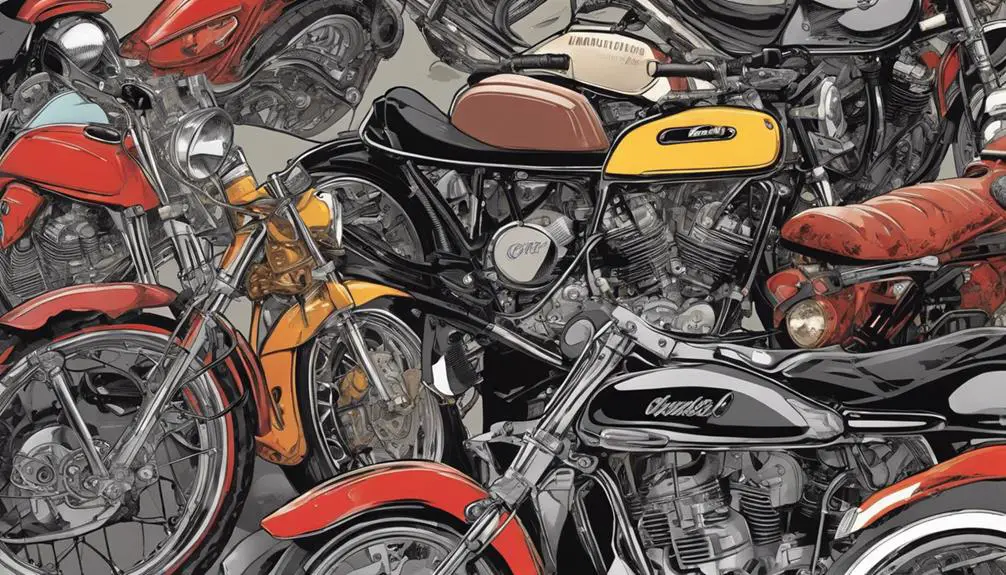You might think that the allure of Italian motorcycles, particularly brands like Ducati, overshadows any concerns about frame issues, but the reality is more complex. These bikes often showcase cutting-edge designs that prioritize performance, which can inadvertently lead to vulnerabilities in their frames. As you explore the interplay of materials, racing heritage, and environmental influences, you'll uncover why these frame problems remain a common topic among enthusiasts. What does this mean for owners who value both style and reliability?
Key Takeaways
- Ducati's innovative frame designs prioritize performance, sometimes leading to stress points that compromise structural integrity.
- The use of lightweight materials like aluminum and carbon fiber can result in fragility if not properly engineered.
- Design flaws, such as poor welds and thin-walled tubing, can create weak joints that fail during aggressive riding.
- Environmental factors like humidity and coastal saltwater exposure can accelerate corrosion and weaken frames over time.
Ducati Motorcycle Frame Design

When you examine Ducati motorcycle frame design, you'll notice a perfect blend of innovation and performance. Ducati pushes boundaries, crafting frames that not only support high speeds but also enhance your riding experience.
The trellis frame, for instance, stands out with its lightweight yet robust structure. It gives you the agility to handle sharp turns and the stability to conquer straightaways.
As you ride, the frame's geometry plays an essential role in how the bike responds to your input. Ducati's attention to detail guarantees that every component works in harmony, providing you with that exhilarating feeling of liberation on the open road. You'll find that the positioning of the engine within the frame contributes to a lower center of gravity, allowing for more confident cornering.
Ducati also utilizes advanced materials, like aluminum and carbon fiber, to reduce weight while maintaining strength. This innovative approach not only enhances performance but also encourages you to explore your limits.
With each ride, you'll feel the freedom that comes from a motorcycle designed to elevate your experience, making every twist and turn on the road a thrilling adventure.
Historical Context of Ducati
Ducati's journey began in 1926, rooted in Bologna, Italy, where the company initially focused on electronics before shifting gears to become a renowned motorcycle manufacturer. You'll find that this transformation shaped Ducati's identity, as they embraced innovation and performance. By the 1950s, Ducati began producing its first motorcycle, the Cucciolo, a small but powerful bike that captured the spirit of freedom.
As you explore deeper into Ducati's history, you'll notice that the brand became synonymous with racing success. The 1970s marked a golden era, with iconic models like the 750 SuperSport showcasing cutting-edge engineering and design. Ducati's commitment to performance and style empowered riders to break free from convention, attracting a dedicated following.
Throughout the years, Ducati faced challenges, yet their resilience only fueled their drive to create exceptional motorcycles. The introduction of the Desmo valve system and the revolutionary trellis frame in the late 20th century exemplified their quest for liberation in motorcycle design.
Today, Ducati remains a symbol of passion, engineering excellence, and the thrill of the open road, inviting you to embrace the ride and experience the freedom that comes with it.
Common Frame Materials Used

As motorcycle technology has evolved, the materials used for frames have become increasingly important in enhancing performance and handling.
You'll often find Italian motorcycles utilizing a mix of materials like steel, aluminum, and even carbon fiber.
Steel frames, known for their durability and great torsional strength, offer a solid foundation, but they can weigh you down.
Aluminum, on the other hand, provides a lighter alternative without sacrificing too much strength, allowing for nimble handling and quicker acceleration. You'll appreciate how it supports a more responsive ride, especially when carving through tight corners.
Carbon fiber is the next level; it's incredibly lightweight and strong, giving you the edge in both speed and agility. However, it comes at a premium, and you might find it mainly in high-end models.
Ultimately, the frame material you choose will impact your riding experience.
Whether you're seeking the raw power of steel or the featherweight performance of carbon fiber, understanding these materials helps you break free and release your true riding potential.
It's all about finding the right balance for your journey on the open road.
Stress Points in Frame Structure
When you're examining stress points in the frame structure of Italian motorcycles, you'll notice design limitations that can impact performance.
You might also encounter material weaknesses that contribute to these vulnerabilities.
Understanding these factors is essential for ensuring your bike's longevity and safety.
Design Limitations
Many Italian motorcycles face inherent design limitations that create stress points in their frame structure, impacting overall performance and safety. When you ride, you want to feel that exhilarating connection with your bike, but these design flaws can hinder that freedom.
Often, the frame geometry prioritizes aesthetics over functionality, leading to awkward angles and stress concentration in critical areas. You might notice how the sleek lines and curves of these bikes can compromise structural integrity. As you navigate tight corners or accelerate, these stress points can lead to fatigue, increasing the risk of failure.
The placement of components, like the engine and suspension, can further exacerbate these issues, creating imbalances that affect handling and response. To truly enjoy the liberation that riding offers, it's crucial to be aware of these limitations.
Material Weaknesses
Understanding the design limitations in Italian motorcycles also brings attention to material weaknesses that contribute to stress points in the frame structure. These weaknesses can manifest in various forms, often leading to performance issues and safety concerns.
When you ride, you want to feel the thrill, not worry about your bike's integrity.
Here are some common material weaknesses you might encounter:
- Thin-walled tubing: While it keeps the bike lightweight, it can lead to fragile frames that bend or crack under stress.
- Subpar welds: If the welding process isn't up to par, it creates weak joints that can fail during aggressive riding.
These stress points might seem minor, but they can greatly impact your ride. It's vital to recognize these issues, as they can detract from the freedom and exhilaration you seek when riding.
Embracing a deeper understanding of these material weaknesses empowers you to make informed decisions about your motorcycle, ensuring you enjoy every twist and turn without fear.
Impact of Racing Heritage

When you think about Italian motorcycles, racing heritage plays a massive role in their design and appeal.
This influence often leads to challenges in prioritizing design elements that cater to both performance and everyday use.
You'll see how this racing legacy shapes not just the bikes themselves, but also the expectations surrounding them.
Historical Racing Influence
Italian motorcycles owe much of their design and performance to a rich racing heritage that has shaped innovations over the decades. This racing pedigree isn't just a badge of honor; it's a driving force behind the bikes you ride today. The thrill of competition pushed manufacturers to find new ways to enhance speed, handling, and agility.
You can see the impact of this heritage in various aspects of Italian motorcycles:
- Engineering Excellence: Racing demands precision, leading to cutting-edge engineering techniques that improve performance.
- Lightweight Materials: To achieve top speeds, manufacturers adopted lightweight materials, making bikes more agile and responsive.
These elements combine to create machines that not only perform exceptionally but also embody the spirit of freedom and adventure.
When you ride an Italian motorcycle, you're not just experiencing a bike; you're tapping into a legacy of speed and passion. So, embrace that feeling, knowing you're part of a long tradition that values performance and the open road.
Design Prioritization Challenges
Balancing performance with everyday usability poses significant design prioritization challenges for manufacturers influenced by their racing heritage. You might wonder why this is the case.
When engineers focus heavily on racing performance, they often overlook the needs of everyday riders. High-speed capabilities, lightweight materials, and aggressive geometries may enhance performance on the track, but they can compromise comfort and stability on the road.
This racing mindset creates motorcycles that may thrill on the circuit but can leave you feeling cramped during daily commutes. You want a bike that liberates you, not one that confines you to a rigid riding position.
Moreover, the emphasis on speed and agility can lead to frame designs that prioritize performance over durability. As a result, the bikes may suffer from frame problems, which can frustrate riders seeking reliability.
Manufacturers face a choice: continue pursuing the thrill of racing or embrace the freedom of a bike that caters to everyday life. Striking the right balance is crucial, as you deserve a motorcycle that harmonizes exhilarating performance with the practicality of daily riding.
After all, liberation isn't just about speed; it's about enjoying the ride on your terms.
Maintenance Practices and Frame Issues
Proper maintenance practices can greatly reduce frame issues in motorcycles, ensuring a safer and smoother ride. By staying on top of your bike's upkeep, you not only prolong its life but also enhance your overall riding experience.
Here are some key maintenance tips to take into account:
- Regularly inspect the frame: Look for cracks or signs of fatigue. Catching issues early can save you from larger problems down the road.
- Check and tighten bolts: Vibration can loosen bolts over time, so make it a habit to check them regularly. A loose bolt can lead to frame misalignment or even failure.
Environmental Factors Affecting Frames

Environmental conditions can considerably impact the integrity of motorcycle frames, making it important to understand how factors like humidity, temperature, and exposure to corrosive substances can affect your ride.
If you live in a humid area, moisture can seep into the frame, leading to rust and weakening the structure. A compromised frame isn't just a mechanical issue; it can threaten your freedom on the road.
Extreme temperatures also play a role. When frames heat up, they can expand, and as they cool, they contract. This cycle can create stress points that weaken the metal over time. You mightn't notice it right away, but those tiny cracks can turn into significant problems down the line.
Additionally, if you frequently ride in coastal areas, saltwater exposure can be particularly damaging. Salt accelerates corrosion, eating away at the metal and shortening the lifespan of your motorcycle.
To maintain your ride's integrity, consider protective coatings or regular inspections, especially if your bike faces these environmental challenges. The road calls for adventure, but staying aware of these factors keeps your ride safe and liberating.
Comparing Ducati to Competitors
When you compare Ducati to its competitors, you'll notice distinct differences in engineering philosophy that shape their motorcycles.
The design aesthetics and performance of a Ducati often set it apart, but you should also consider reliability and maintenance issues that can arise.
Understanding these factors will help you appreciate what makes Ducati unique in the motorcycle market.
Engineering Philosophy Differences
Ducati's engineering philosophy sets it apart from competitors by emphasizing performance and innovation, often pushing the boundaries of traditional motorcycle design. You'll find that this approach manifests in several key ways:
Cutting-edge Technology: Ducati constantly integrates advanced materials and systems, ensuring each bike remains at the forefront of performance.
Rider-Centric Design: Every detail is crafted with the rider in mind, optimizing control and comfort, so you can truly feel the thrill of the ride.
Racing Heritage: With a rich history in motorsports, Ducati channels that competitive spirit into its engineering, resulting in bikes that aren't just machines, but extensions of your passion for freedom.
In contrast, many competitors play it safe, sticking to conventional designs that may lack the excitement you crave. While their bikes can be reliable, they mightn't ignite that same sense of liberation you seek.
Ducati dares to challenge norms, inviting you to experience the ride in a whole new way. When you choose a Ducati, you're not just riding; you're embracing a philosophy that celebrates the exhilarating journey of life on two wheels.
Design Aesthetics and Performance
Italian motorcycles, especially Ducati, seamlessly blend stunning design aesthetics with high-performance engineering to create a riding experience that captivates both the eyes and the senses. When you sit on a Ducati, you feel the passion and precision that goes into each model. Its aggressive lines and bold colors not only turn heads but also enhance aerodynamics, giving you an edge on the road.
Comparing Ducati to competitors like Yamaha or Kawasaki, you'll notice that Ducati prioritizes both form and function. While others may focus solely on power or design, Ducati strikes a harmonious balance. You're not just riding; you're making a statement. The attention to detail in Ducati's craftsmanship is unparalleled, reflecting Italian artistry that resonates with freedom and individuality.
Moreover, the performance is exhilarating. Ducati's powerful engines deliver torque and speed that thrill you, while the lightweight chassis allows for nimble handling, empowering you to tackle corners with confidence.
Fundamentally, riding a Ducati isn't just about getting from point A to B; it's about the journey itself, where every twist of the throttle liberates your spirit and invites you to embrace the open road.
Reliability and Maintenance Issues
While Ducati motorcycles are renowned for their performance and aesthetics, they can sometimes fall short in reliability compared to competitors like Yamaha and Kawasaki, which are often praised for their durability and lower maintenance costs.
If you're seeking the thrill of the ride without the constant worry of breakdowns, it's crucial to evaluate your options carefully.
Here are some key factors to ponder when comparing Ducati to its competitors:
- Maintenance Frequency: Ducatis typically require more frequent servicing, which can be a hassle if you're looking for a bike that can handle the long haul.
- Parts Availability: You may find that parts for Yamaha and Kawasaki are more readily available and often less expensive, saving you both time and money.
Ultimately, while Ducati offers an exhilarating ride, balancing performance with reliability can lead you to freedom on the road.
Reflect on your priorities and choose a motorcycle that aligns with your desire for adventure and peace of mind.
Owner Experiences and Reports

Many owners report a mix of excitement and frustration when dealing with frame issues in their motorcycles. You might feel that thrill of freedom as you ride, yet that joy can quickly turn into concern when frame problems arise.
Many riders express their love for Italian craftsmanship but often find themselves grappling with unexpected challenges. It's not just about the speed and style; it's about feeling secure on the road.
You might hear stories from fellow enthusiasts who've experienced everything from minor tweaks to major overhauls. They share moments of elation when they finally tackle an issue, only to discover new concerns lurking beneath the surface. These frame problems can feel like a betrayal from a trusted companion, testing your loyalty and patience.
You want to ride without a worry, feeling that exhilarating connection to the open road. Yet, many owners navigate a landscape of uncertainty, weighing their passion against the reality of repairs.
It's a delicate balance, one that can lead to deeper camaraderie among riders as they seek shared experiences and solutions. Ultimately, you're not alone in this journey; countless others share your quest for liberation on two wheels.
Solutions for Frame Problems
To tackle frame problems effectively, you should first assess the specific issues your motorcycle is facing before diving into repairs or modifications. Understanding the root cause of the problem will save you time and effort in the long run.
Once you've identified the issues, consider these solutions to liberate your ride from frame troubles:
- Reinforce Weak Points: Strengthening the frame at known weak spots can prevent future issues. This might involve welding or using additional supports to enhance stability.
- Upgrade Components: Sometimes, swapping out stock parts for higher-quality alternatives can greatly improve structural integrity. Look for parts designed for performance and durability.
Frequently Asked Questions
What Specific Frame Problems Are Most Prevalent in Italian Motorcycles?
When you immerse yourself in Italian motorcycles, you'll notice some specific frame problems often arise.
Cracks can form in the frame due to stress, especially in high-performance models. You might also encounter issues with alignment, which affects handling and stability.
Additionally, corrosion can be a concern in certain conditions, weakening the structure.
Being aware of these problems helps you make informed decisions and guarantees your ride stays as thrilling as it should be.
How Does Frame Geometry Influence Motorcycle Handling and Performance?
Did you know that over 60% of riders report improved confidence with the right frame geometry?
When you're on your motorcycle, the frame's design directly affects how you handle corners and respond to speed.
A well-balanced geometry lets you feel liberated, allowing for smoother turns and quicker reactions.
You'll experience a more exhilarating ride, as the bike becomes an extension of you, enhancing both performance and your overall connection to the road.
Are Frame Problems More Common in High-Performance Models?
You might find that frame problems can be more common in high-performance motorcycle models.
These bikes often push the limits of design and engineering, prioritizing speed and agility over durability.
When you're riding at high speeds, even minor frame imperfections can lead to significant handling issues.
What Role Do Manufacturing Processes Play in Frame Durability?
When you think of a sturdy frame, you might recall the strength of ancient bridges, standing tall against time.
Manufacturing processes are essential for frame durability; they determine the materials used and how they're treated.
If a manufacturer cuts corners or skips quality checks, you'll likely face issues down the road.
How Can Riders Identify Frame Issues Early On?
To identify frame issues early on, you should regularly inspect your motorcycle for any signs of wear or damage.
Look for cracks, bends, or rust, especially around welds and joints.
Pay attention to unusual vibrations or handling changes while riding, as these can signal deeper problems.
Don't ignore strange noises either; they might indicate something's off.
Staying proactive in your inspections can save you from more serious issues down the road.
Conclusion
While you might worry that frame issues make Ducati motorcycles unreliable, the truth is that with proper care and regular inspections, you can greatly enhance their performance and longevity.
Embracing their racing heritage means understanding the trade-offs between weight and durability.
By staying proactive with maintenance, you can fully enjoy the thrilling ride these bikes offer without the nagging fear of frame problems.
Immerse yourself in the Ducati experience—it's worth it!